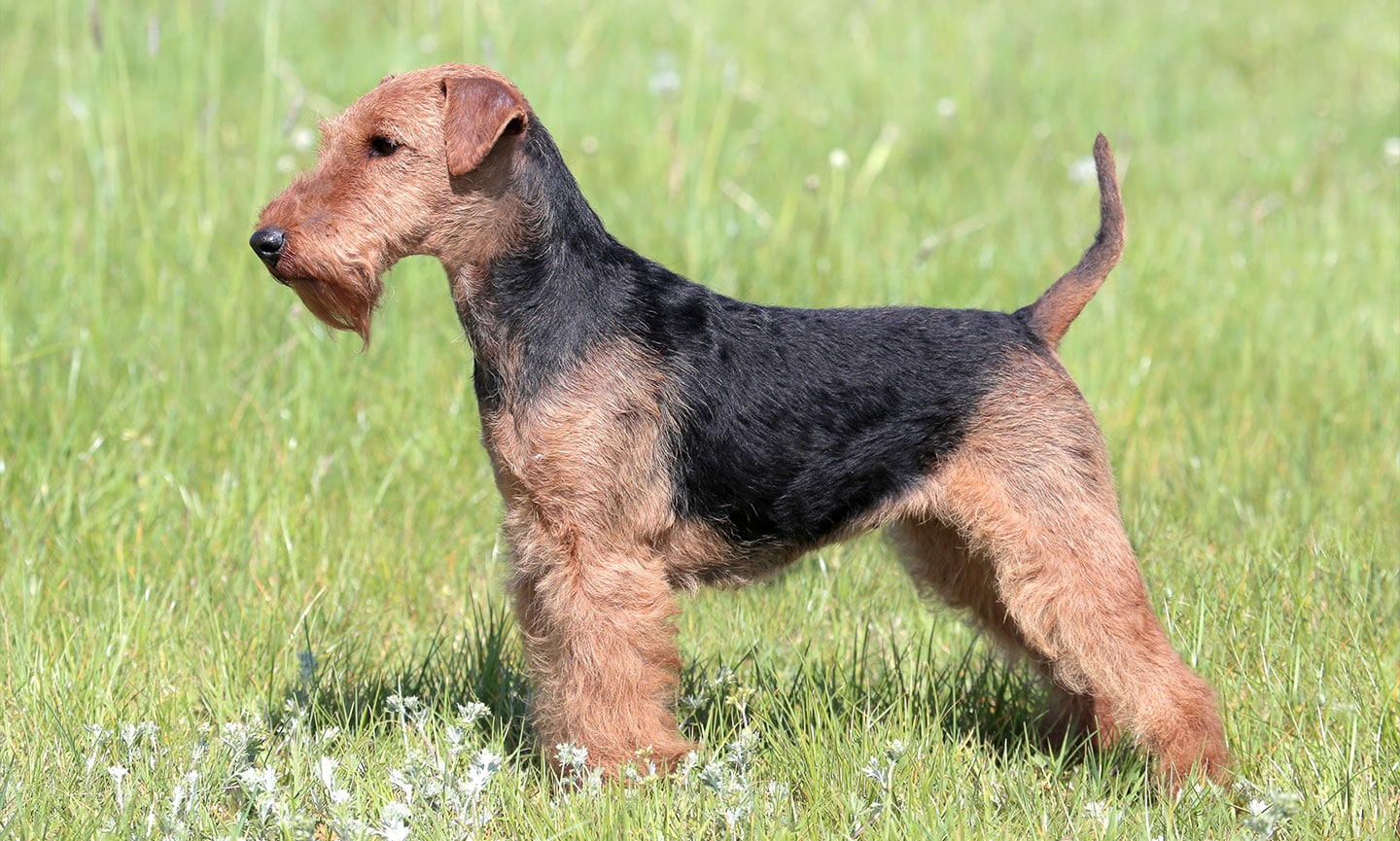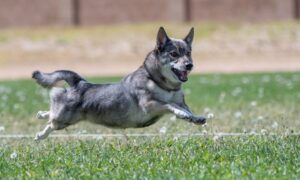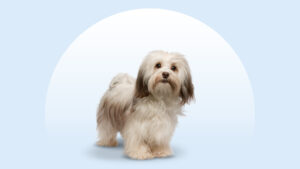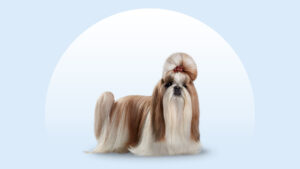Welsh Terrier
Updated May 5, 2025
Welsh Terrier
Updated May 5, 2025
Welsh Terriers are spirited and friendly dogs known for their funny, playful antics. They thrive in active homes with experienced pet parents who appreciate their lively nature and can provide consistent training.
Fun-loving, Spirited, High-energy
Male: 20 pounds
Female: Proportionally smaller than the male.
Male: 15 inches
Female: Proportionally smaller
12 to 15 years
Black and Tan, Grizzle and Tan
Ready to add some excitement to your life? Bring home a Welsh Terrier. This fun-loving breed is full of surprises—they’ll happily play with their toys one minute, run around the yard chasing anything that moves the next, and then snatch your favorite sneakers when you aren’t looking. Still, as mischievous as they can sometimes be, one flashy smile from their funny, fuzzy face and you’ll forgive everything. (You know you’re a softie at heart.) You love a good laugh, so you’ll get a kick out of your Welshie’s playful antics, keeping you in stitches throughout the day. But their affectionate nature means they’ll also be just the companion you’ve been looking for at night when you both finally slow down. You’d been meaning to replace those ratty sneakers anyway, right?
Welsh Terrier Characteristics
Welsh Terrier Appearance
Welsh Terriers’ height, long-muzzled head and “stuffed toy” good looks can be deceiving. Beneath their adorable exterior, these energetic dogs are small powerhouses with the stamina to keep up with any task you throw their way. Their tails are always alert and upright, and they love nothing more than using their square noses to dig around for their next big adventure. These black and tan terriers will melt your heart when their sweet, fuzzy face looks up at you through alert, almond-shaped eyes.
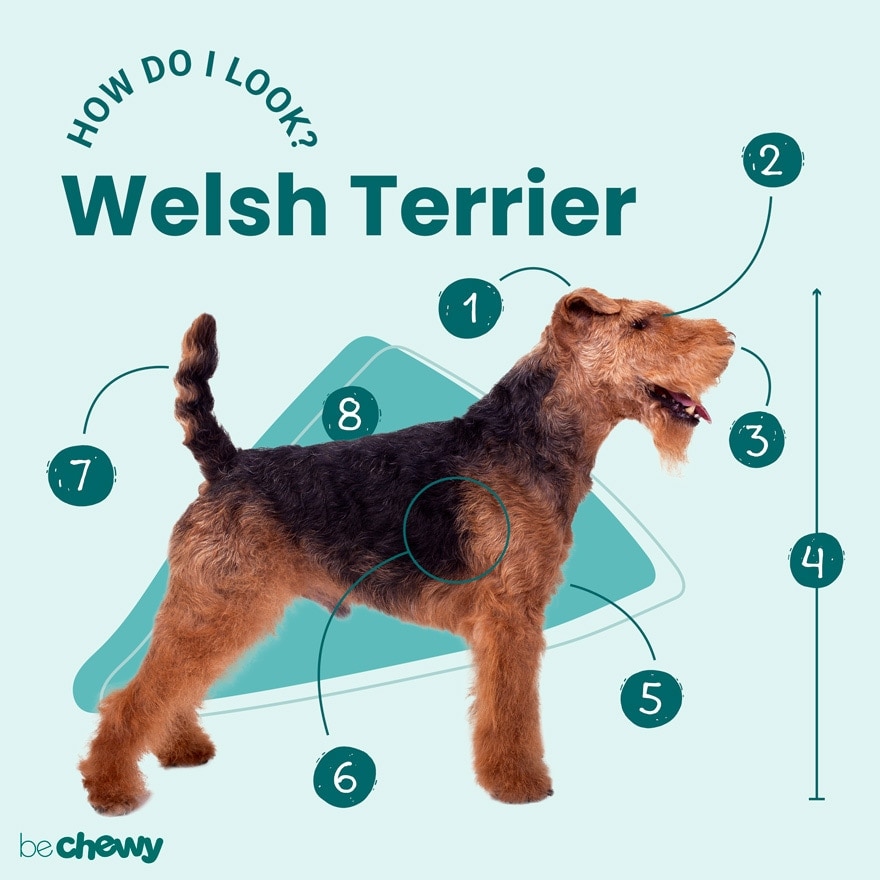
- Ears
Welsh Terrier ears are small and v-shaped, folding over toward the front of the head.
- Eyes
Welsh Terrier eyes are small, almond-shaped and dark brown in color.
- Nose
The Welsh Terrier nose is black and square-shaped.
- Coat Length
The Welshie coat is dense, wiry and thick with a short, soft undercoat.
- Coat Color
Welsh Terrier colors are black (or grizzle, a blended color of black and tan) on the jacket of the body, the neck and the upper thighs. The legs, quarters and head come in shades of tan.
- Tail
The AKC breed standard calls for the tail to be docked. Docking involves cutting a portion of the dog’s tail off when they are puppies. Veterinary groups along with many U.S. states and countries have banned this procedure due to medical and behavioral reasons. If you are interested in this procedure, schedule a consultation with your veterinarian.
Welsh Terrier Temperament
The Welsh Terrier dog breed is affectionate with the people they love. They’re outgoing, spirited and highly alert. No wallflowers here! On the flip side, they’ll likely chase and bark after any little critter that moves.
Welshies are not naturally aggressive, nor do they have strong biting tendencies. But as a hunting breed, untrained dogs (and sometimes even the trained ones) will chase after small animals, including cats, and fight back if challenged by other dogs. Pro tip: If buying or adopting two dogs at once, getting one of each gender may result in a smoother transition.
A Welsh Terrier’s fun-loving temperament can make them great pets who can co-exist beautifully with active parents. Raising a Welshie with kids is more of a mixed bag. The best chance for happy cohabitation depends on the young children’s age at the time the dog enters the home (older than 6 is your best bet), and whether you provide diligent supervision and socialization—both for your dog, and to teach your children how to respectfully interact with them.
A medium- or large-sized home with plenty of indoor and outdoor space—a big fenced yard, for example—to speed around in is ideal. They definitely need room to get the zoomies out. Small apartment living can also work, as long as you give your pup plenty of outdoor opportunities to race. But be warned: Due to their high energy and natural hunting tendencies, Welshies tend to jump on furniture to make room for play. They should always be on a leash when out in public, too.
This breed isn’t the best choice for first-time dog parents as Welsh Terriers’ intelligence and high energy levels demand above-average physical exercise as well as a ton of training and mental stimulation for them to thrive. Regardless, if a Welsh Terrier puppy has already won your heart, make sure they come from a reputable breeder and invest in a certified trainer to end up with the best Welsh Terrier qualities and a devoted forever friend.
How to Care for a Welsh Terrier
The Welsh Terrier breed may look like a huggable, wiry-haired stuffed prize you won at the fair, yet surprisingly, they don’t need a lot of brushing to keep them looking their cuddly best. They do, however, require plenty of daily activities and mental stimulation, a balanced diet, plus regular nail trimming and teeth brushing routines to keep them happy and healthy for a lifetime.
Grooming
Training
Diet
Exercise
Environment
Welsh Terrier Health
Welsh Terriers have a life expectancy of 12 to 15 years and, in general, are a healthy breed. Still, Welshies can be prone to a number of health problems. It’s important to be aware of some common Welshie health issues that may affect your beloved pooch.
- Hip Dysplasia: Hip dysplasia is a condition in which the hip joint isn’t formed properly, causing instability of the joint and leading to pain. Though it’s more commonly linked to large breed dogs, the condition can also affect Welsh Terriers. Signs include limping, being slow to rise from laying down, “bunny hopping” or showing pain when walking. Responsible breeders are required to conduct testing with a recognized certification organization. Treatments for the condition include lifestyle changes, joint supplements, medication and, in severe cases, surgery.
- Ocular Conditions: Eye conditions are quite common in Welsh Terriers, including keratoconjunctivitis sicca (dry eye), glaucoma (primary or secondary), as well as genetic (lens luxation) or age-related conditions (glaucoma) that may ultimately require surgery. Breeders are required to do annual evaluations and DNA testing to avoid inherited conditions in future offspring.
- Epilepsy: This is a change in electrical activity of the nervous system that leads to physical events (chewing, stiffening of the legs and body, tremoring, seizures) and severe episodes where a dog can lose awareness of their surroundings. This can be a very scary event to witness, and indicates that your dog needs to be examined by your vet right away. Many times, epilepsy can be controlled using medications, diet, and monitoring with examinations and bloodwork.
- Allergies: Like most terriers, Welsh Terriers are prone to allergies, mainly manifesting in skin conditions such as atopic dermatitis, a severe immune reaction of the skin responding to allergens. Treatment includes immunomodulatory medication with the use of an antibiotic or an antifungal medication, depending on what infectious agent is identified by your veterinarian.
- Legg-Calve-Perthes Disease: This degenerative hip joint condition, which primarily affects small breeds, eventually results in a collapsed hip and arthritis. Mild cases can be treated with therapy, while more severe situations require surgery.
Welsh Terrier History
Welsh Terrier origins date back to the 1700s. Originally bred to mercilessly hunt and kill vermin, including rodents, foxes, otters and badgers, Welshies later ran in dog packs during fox hunts and were eventually primed to compete in dog shows.
The Welsh Terrier’s history of having a hardwired instinct to chase small prey is still a large part of the modern Welsh Terrier personality. They excel at keeping pests at bay on a farm, but at home, they are affectionate pets who adore spending time with their loved ones or chasing pests in the yard.
Things got official for the Welsh Terrier during the 19th century. The Kennel Club in London, United Kingdom, recognized Welsh Terriers as a breed in 1887 and, following the first exports in 1885, the American Kennel Club gave Welshies full recognition in 1888.
So, where is the best place to find the Welsh Terrier breed today? You can find a list of reputable breeders at the American Kennel Club’s Marketplace or Welsh Terrier Club of America. Depending on the breeder, Welsh Terrier pup prices average between $800 to $1,200. For this cost, you’ll typically get a Welsh Terrier who’s been responsibly bred to avoid temperament and health issues. You can also contact Welsh Terrier rescue organizations to adopt a dog, keep an eye out for the breed at your local animal shelter, or search Chewy’s database of adoptable dogs in your area.
FAQs
Do Welsh Terriers shed?
Are Welsh Terriers good family dogs?
How long do Welsh Terriers live?
How big do Welsh Terriers get?
Do Welsh Terriers bark a lot?
What are the most popular Welsh Terrier names?
What are the most common Welsh Terrier mixes?
Expert input provided by DiAnn Flory, AKC Breeder of Merit, AKC judge and owner of MoorGreen Terriers, veterinarian Dr. Rachel Barrack, DVM, CVA, CVCH founder of concierge veterinary practice Animal Acupuncture, Amber Walker, KPA-CTP, zoologist, and owner of Animal Intuitions and Mary Thompson CPDT-KA PMCT1, certified professional dog trainer at Happy Hound University.
Breed characteristic ratings provided by veterinarian Dr. Sarah J. Wooten, DVM, CVJ, a veterinarian at Sheep Draw Veterinary Hospital in Greeley, Colorado; dog trainer and behavior consultant Irith Bloom, CPDT-KSA, CBCC-KA, CDBC, owner of The Sophisticated Dog, LLC, in Los Angeles; and certified animal behavior consultant Amy Shojai, CABC, in Sherman, Texas.
The health content was medically reviewed by Chewy vets.
